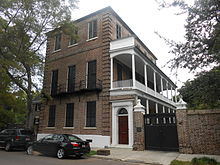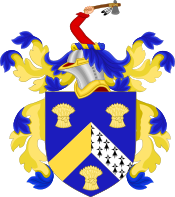Thomas Heyward Jr.
Thomas Heyward Jr. | |
|---|---|
 Thomas Heyward Jr. | |
| Born | July 28, 1746 |
| Died | March 6, 1809 (aged 62) |
| Resting place | Heyward Family Cemetery, Old House |
| Known for | signer of the United States Declaration of Independence |
| Signature | |
Thomas Heyward Jr. (July 28, 1746 – March 6, 1809) was a signer of the United States Declaration of Independence and of the Articles of Confederation as a delegate of South Carolina.
Background[]
Heyward was born in St. Luke's Parish (now known as Jasper County),[1][2] South Carolina, the son of Mary (Miles) and Daniel Heyward.[3] He was educated at home, then traveled to England to study law where he was a member of the Honourable Society of the Middle Temple. He was elected to the Continental Congress in 1775 and the following year signed the Declaration of Independence.
Heyward returned to South Carolina in 1778 to serve as a judge. In command of a militia force, he was taken prisoner by the British during the siege of Charleston. In 1784, he was elected a member of the American Philosophical Society.[4] He continued to serve as a judge after the war, retiring from the bench in 1798.
He is buried at Old House Plantation near Ridgeland, Jasper County, South Carolina.[5] It was added to the National Register of Historic Places in 1997.[6]
In 1970, when the Supreme Court ordered that public schools must be integrated, a group associated with the White Citizen's Council opened a school named Thomas Heyward Academy in Ridgeland, South Carolina. Their nickname is the rebels and colors are red and gray.[7][8]
Marriage and family[]

Heyward was married twice, at age 26, and at age 40, and each wife was named Elizabeth. The first Elizabeth, daughter of Col. John and Sarah Gibbes Mathews, born 1753, and whose brother, John, was Governor of South Carolina, died in childbirth in 1782 in Philadelphia, where she had gone to be with him upon his release as a prisoner of war. She is buried there in St. Peter's Episcopal Church yard. They had six children, but only one son, Daniel, survived childhood. The second Elizabeth, 1769–1833, daughter of Col. Thomas and Mary Elliott Savage of Charleston, S.C., had three children to live to adulthood, Thomas, William and Elizabeth. There are a number of descendants today in the 21st century surviving his four children. Notable descendants include DuBose Heyward, whose novel and later stage play Porgy portrayed blacks without condescension, and was transformed by George Gerswhin into the popular opera Porgy and Bess, an American musical masterpiece.[9]

At one time the Heyward family had the largest slaveholding in the United States.[10]
Detention[]
On August 27, 1780, Heyward was taken from his Charleston home by British troops and detained in the Old Exchange Building. Just hours after being arrested, he and 28 other "ringleaders of the rebellion" were relocated to a guard ship in the harbor. On September 4, they were transported to St. Augustine, Florida, and remained there for about 11 months until they were freed in a prisoner exchange.[11]
See also[]
References[]
- ^ Champlin, Kelly. "Ghosts of Thomas Heyward's past". Jasper County Sun. Retrieved 20 February 2014.
- ^ National Park Services. "Biographical Sketches: Thomas Heyward Jr". Retrieved 20 February 2014.
- ^ Peeples, Robert E. H. (1965). "A Miles Genealogy: A Family of South Carolina Planters". The South Carolina Historical Magazine. 66 (4): 229–240. JSTOR 27566602.
- ^ "APS Member History". search.amphilsoc.org. Retrieved 2020-12-08.
- ^ "Old House Plantation, Jasper County (Address Restricted)". National Register Properties in South Carolina. South Carolina Department of Archives and History. Retrieved June 2014. Check date values in:
|access-date=(help) - ^ "National Register Information System". National Register of Historic Places. National Park Service. July 9, 2010.
- ^ "White Parents Flee Public Schools". Federal Times. Army Times Publishing Company. 1 January 1971.
- ^ Hawes, Jennifer; Adcox, Seanna; Bowers, Paul; Moore, Thad; Smith, Glenn (November 14, 2018). "No accident of history". The Post and Courier. Retrieved 2021-02-24.
Thomas Heyward Academy opened in rural Jasper County in 1970, the year that most districts in South Carolina desegregated under court order. It was one of dozens of private schools that opened to white students as the state resisted integration in the late 1960s and 1970s.
- ^ "Thomas Heyward Jr". The Society of the Descendants of the Signers of the Declaration of Independence. Retrieved 12 July 2020.
- ^ Dusinberre, William (1996). Them Dark Days: Slavery in the American Rice Swamps. Oxford University Press. p. 4. ISBN 9780198025108.
- ^ "The Charleston Museum | News and Events » the Taking of Thomas Heyward".
External links[]
| Wikimedia Commons has media related to Founding Fathers of the United States. |
- United States Congress. "Thomas Heyward Jr. (id: H000555)". Biographical Directory of the United States Congress.
- Rev. Charles A. Goodrich, "Thomas Heyward Jr.", in Lives of the Signers to the Declaration of Independence, New York: William Reed & Co., 1856, pp. 440–443
- Thomas Heyward Jr. at Find a Grave
- 1746 births
- 1809 deaths
- American Revolutionary War prisoners of war held by Great Britain
- Continental Congressmen from South Carolina
- 18th-century American politicians
- Signers of the Articles of Confederation
- Signers of the United States Declaration of Independence
- Members of the Middle Temple
- People from Ridgeland, South Carolina
- American slave owners
